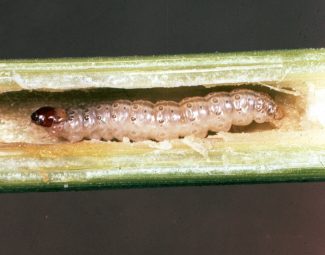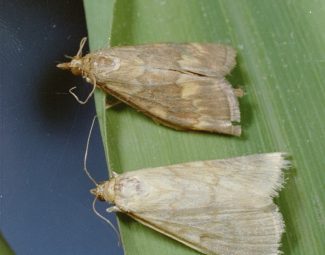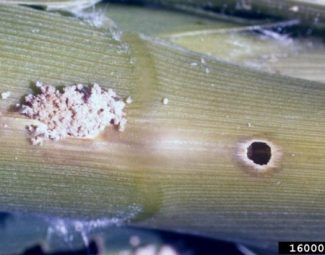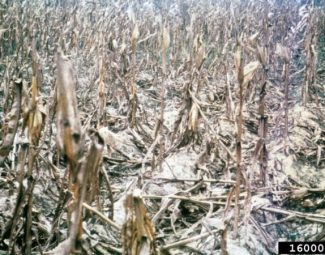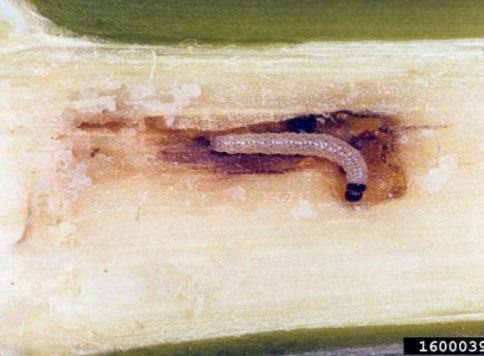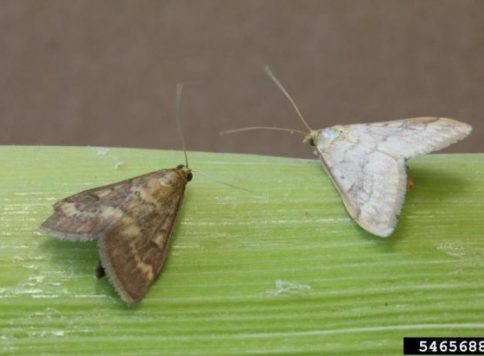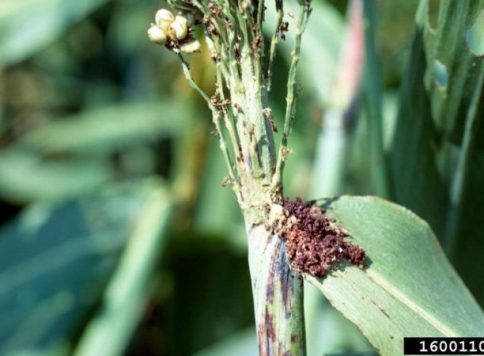European Corn Borer
Insect Summary Report
Ostrinia nubilalis
General Information
- US and Canada’s most damaging corn pest.
- Infest at least 250 plants including corn, beans, pepper and potato. Other alternate hosts include buckwheat, hops, oats, millet, soybeans, and various flower species. Corn is usually preferred if available. Will bore into virtually any host with stems large enough to burrow into.
- Weed hosts include: barnyardgrass, beggarticks, cocklebur, dock, jimsonweed, panic grass, pigweed, and smartweed.
- Larva tunnel into stems of host plants. Tunneling weakens the stem; often leading to lodging, eardrop, stem breakage, tassel breakage, and impedes host plant’s ability to transport nutrients. Also causes serious damage to grain and sweet corn by direct feeding on ears and kernels. Fruits of other host plants also damaged by direct feeding. Feeding damage also increases vulnerability to various diseases.
- Heavy rains and strong winds increase mortality of eggs and small larva. These conditions also suppress mating and egg lay when they occur during the first hours of the night.
- Warmer climates such as Texas can experience as many as four generations.
- Use sex pheromone for mating recognition. Identified as 11-tetradecenyl acetate.
Life Cycle (1-4 generations/year)
- Eggs… (4-9 Days) Flat, oval and iridescent white in color. Deposited in clusters of 15-20 on bottoms of leaves. Laid in overlapping, shingle configuration that gives a scale-like appearance. Approx. 1 mm.
- Larva… (15-21 Days) 6 instars. Brown or pink on top with a whitish-yellow underside and dark spots on each segment. Black or brown head. 1.5-20 mm. Usually initial feeding takes place within the whorl and/or tassel of corn, then tunnel into the midribs, main stalk, ear base and ear kernels.
- Pupa… (12 Days) Reddish-brown in color. 13-17 mm. Spines at the end of abdomen anchor pupa to host.
- Adult… (18-24 Days) 20-44 mm. Females are larger than males. Pale yellow to light brown with darker zigzag lines across width of wings. Pre-oviposition period of 3-4 days. Will lay eggs at a rate of 20-50 per day for approx. 14 days. Most active during the first 3-5 hours of darkness. Will seek shelter from heat during daylight hours in grasses and cracks in ground.
Over-wintering Strategy
Over-winters in larval stage within the tunnel of the host plant. Continue development into pupa and adult in spring when temps. > 50 degrees F. Adults usually become active in April in warmer climates such as Texas.
Sampling
- Moths can be sampled with traps baited with synthetic pheromone or blacklight. Pheromone traps will only attract male moths. Pheromones are specific for northern and southern strain of moths. Trap catches can be used to indicate need for visual sampling of egg masses and larval damage. The whorl of cotton should be inspected prior to tassel for presence of larva. “Shotholes” in leaves can indicate earlier whorl-stage feeding. “Sawdust” excrement around feeding sites may be seen.
- Heat unit models may be useful in predicting generational development and emergence.
Organic Control
- General Info
- Several native wasp and fly parasites serve as natural control in most conditions. Trichogramma wasps have been identified as being parasites of the eggs and are commercially available for augmentative release. Various fungal and bacterial pathogens also serve as important natural controls.
- Naturally occurring predators of eggs and larva include: minute pirate bugs, lacewings, ladybird beetles and various bird species.
- Electric light traps. Adults are drawn to the light.
- Commonly Used Products
- Ferti-Neem Oil
- Ferti-Organics Karanja Oil
- Biorepel (Garlic Oil)
- Bt: Agree; Xentari; Dipel; Javelin
- Entrust (Spinosad)
- Neemix 4.5 (Botanical)
- Gemstar (Biological)
- BoteGHA ES (Biological)
Cultural Control
- Maintain good fertility and mineral balance in plants. Identify macro- and micro- nutrient deficiencies by performing plant tissue and soil analysis. Adjust for deficiencies with foliar and soil applied applications of appropriate fertilizers.
- If transplants are used, inspect them before purchase for signs of feeding and egg deposition.
- Destroy vegetative materials and crop residue immediately after harvest by disking or burning.
- Control or mow weeds that serve as hosts.
- Early spring planting and/or early maturing varieties can encourage early harvest before populations build to economic thresholds. However, late maturing crops may be subjected to late season populations.
- When possible, schedule 2-3 months or more when host crops are not available. This is most effective during winter months when environmental conditions are most severe for pest survival.
- Plant varieties less susceptible to corn borer damage. Hot peppers are less susceptible than bell peppers.
- Establish and maintain balanced biology in the soil to breakdown crop residues left in soil that may shelter diapausing larva. SP-1 and/or Residuce may be used to augment soil’s capacity for organic decomposition.
More Images of the European Corn Borer
Bibliography
- Image by Adam Sisson, Iowa State University, Bugwood.org (adults)
- Images by Frank Peairs, Colorado State University, Bugwood.org (eggs, larva, pupa, adult female, and shot hole damage)
- Images by John C. French Sr., Retired, Universities:Auburn, GA, Clemson and U of MO, Bugwood.org (damage to grain sorghum, internal feeding tunnel, damage to corn field, and egg mass hatching)
- Images by Clemson University – USDA Cooperative Extension Slide Series, Bugwood.org (larva and adults)
- Capinera, John L., University of Florida, 2000 (life cycle, preferred host plants, preferred weeds, pheromone, over-wintering, sampling) http://creatures.ifas.ufl.edu/field/e_corn_borer.htm
- Gessell, Stanley and Dennis Calvin. Penn State University, Sept. 9, 2000;(Number of host plants) http://www.ento.psu.edu/Extension/factsheets/european_corn_borer.htm
- Boucher, Jude; University of Connecticut, Pepper IPM Integrated Pest Management.(Coventional control) http://www.hort.uconn.edu/Ipm/veg/htms/pprborer.htm
- Sorenson, K.A., North Carolina State University, Vegetable Insect Pest Management Corn Borer in Potatoes. March 2005. (Conventional control) http://www.ces.ncsu.edu/depts/ent/notes/Vegetables/veg2.html
- Youngerman, Roger R. and Eric R. Day. Virginia Tech University, Virgina Cooperative Extension. Publication 444-232. Aug. 1996. (Effect of weather conditions on mortality) http://www.ext.vt.edu/departments/entomology/factsheets/eurcobo.html
- Ostlie K.R,, W.D. Hutchison, & R. L. Hellmich Bt Corn and European Corn Borer. Long Term Success Through Resistance Management. Regents of the University of Minnesota 2002. (Corn pest rank) http://www.extension.umn.edu/distribution/cropsystems/DC7055.html


